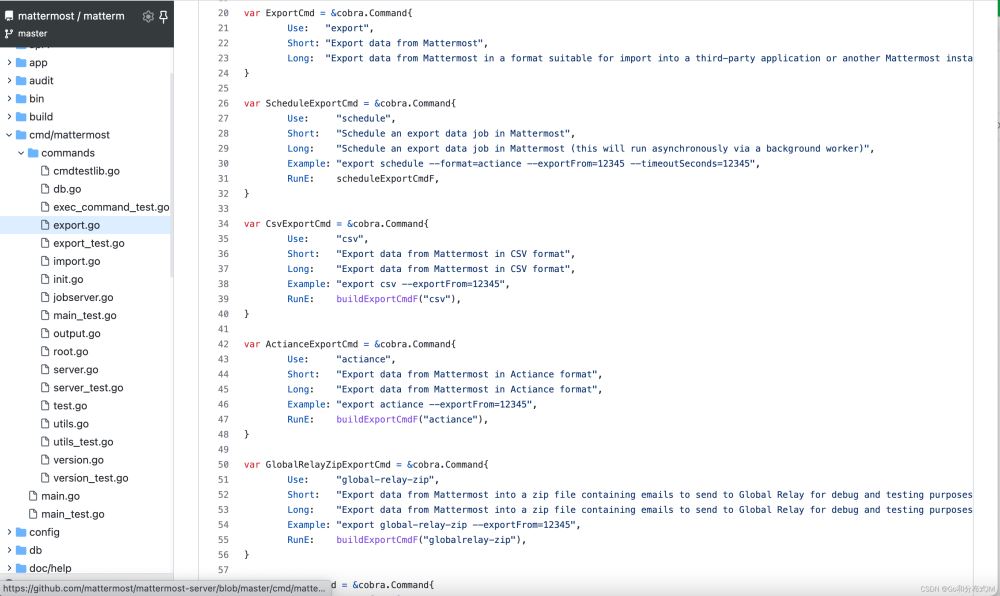go Cobra命令行工具入门教程
来源:脚本之家
时间:2022-12-30 13:59:42 475浏览 收藏
怎么入门Golang编程?需要学习哪些知识点?这是新手们刚接触编程时常见的问题;下面golang学习网就来给大家整理分享一些知识点,希望能够给初学者一些帮助。本篇文章就来介绍《go Cobra命令行工具入门教程》,涉及到命令行、goCobra,有需要的可以收藏一下
简介
Github:https://github.com/spf13/
cobraStar:26.5K
Cobra是一个用Go语言实现的命令行工具。并且现在正在被很多项目使用,例如:Kubernetes、Hugo和Github CLI等。通过使用Cobra,我们可以快速的创建命令行工具,特别适合写测试脚本,各种服务的Admin CLI等。比如 Mattermost 项目,就写了很多 Admin CLI:

为什么需要cobra
我们看一个简单的demo使用前
package main
import (
"flag"
"fmt"
)
func main() {
flag.Parse()
args := flag.Args()
if len(args)
<p>使用后</p>
<pre class="brush:go;">package main
import (
"fmt"
"github.com/spf13/cobra"
"os"
)
// rootCmd represents the base command when called without any subcommands
var rootCmd = &cobra.Command{
Use: "api",
Short: "A brief description of your application",
Long: `A longer description `,
}
// 命令一
var mockMsgCmd = &cobra.Command{
Use: "mockMsg",
Short: "批量发送测试文本消息",
Long: ``,
Run: func(cmd *cobra.Command, args []string) {
fmt.Println("mockMsg called")
},
}
// 命令二
var exportCmd = &cobra.Command{
Use: "export",
Short: "导出数据",
Long: ``,
Run: func(cmd *cobra.Command, args []string) {
fmt.Println("export called")
},
}
func Execute() {
err := rootCmd.Execute()
if err != nil {
os.Exit(1)
}
}
func init() {
rootCmd.Flags().BoolP("toggle", "t", false, "Help message for toggle")
rootCmd.AddCommand(mockMsgCmd)
rootCmd.AddCommand(exportCmd)
exportCmd.Flags().StringP("out", "k", "./backup", "导出路径")
}
func main() {
Execute()
}
运行:
$ go run main.go A longer description Usage: api [command] Available Commands: completion Generate the autocompletion script for the specified shell export 导出数据 help Help about any command mockMsg 批量发送测试文本消息 Flags: -h, --help help for api -t, --toggle Help message for toggle Use "api [command] --help" for more information about a command.
发现了吗?你不用再处理各种参数组合了,从此释放了出来,只需要写自己的业务逻辑即可!
基本概念
Cobra由三部分组成:
- 命令(Commands ):代表行为。命令是程序的中心点,程序的每个功能都应该可以通过命令进行交互,一个命令可以有任意个子命令。
- 参数(Args):命令的参数
- 标志(Flags):修饰命令。它修饰命令该如何完成。
官方推荐命令格式为:
$ ./appName command args --Flag
如 hugo server --port=1313 :
- appName: hugo
- command: server
- flag: port
安装
Go pkg
添加依赖
$ go get -u github.com/spf13/cobra@latest
导入即可:
import "github.com/spf13/cobra"
命令行工具
建议安装命令行工具 `cobra-cli` ,以方便快速创建cobra项目,增加command等。
# 命令行工具 $ go install github.com/spf13/cobra-cli@latest
安装完成之后,执行 `cobra-cli --help` (请确保GOBIN已配置),输出下列信息则代表成功:
$ cobra-cli --help
Cobra is a CLI library for Go that empowers applications.
This application is a tool to generate the needed files
to quickly create a Cobra application.
Usage:
cobra-cli [command]
Available Commands:
add Add a command to a Cobra Application
completion Generate the autocompletion script for the specified shell
help Help about any command
init Initialize a Cobra Application
Flags:
-a, --author string author name for copyright attribution (default "YOUR NAME")
--config string config file (default is $HOME/.cobra.yaml)
-h, --help help for cobra-cli
-l, --license string name of license for the project
--viper use Viper for configuration
Use "cobra-cli [command] --help" for more information about a command.
入门实践
新建cobra命令行程序
安装了cobra-cli工具之后,执行 init 初始化创建项目:
$ cobra-cli init
此时,在当前目录自动生成如下文件:
├── LICENSE ├── cmd │ └── root.go └── main.go
main.go:
package main
import "tools/api/cmd"
func main() {
cmd.Execute()
}
root.go(有删减):
package cmd
import (
"fmt"
"github.com/spf13/cobra"
)
// rootCmd represents the base command when called without any subcommands
var rootCmd = &cobra.Command{
Use: "api",
Short: "A brief description of your application",
Long: `A longer description `,
//Run: func(cmd *cobra.Command, args []string) {
// fmt.Println("api called")
//},
}
// Execute adds all child commands to the root command and sets flags appropriately.
// This is called by main.main(). It only needs to happen once to the rootCmd.
func Execute() {
err := rootCmd.Execute()
if err != nil {
os.Exit(1)
}
}
func init() {
// 全局flag
// rootCmd.PersistentFlags().StringVar(&cfgFile, "config", "", "config file (default is $HOME/.api.yaml)")
// local flag,暂不知道用处
rootCmd.Flags().BoolP("toggle", "t", false, "Help message for toggle")
}
此时运行,不用指定参数,会执行rootCmd,打印使用说明:
$ go build $ ./api
输出:
A longer description
Usage:
api [command]
Available Commands:
completion Generate the autocompletion script for the specified shell
help Help about any command
Flags:
-h, --help help for api
-t, --toggle Help message for toggle
Use "api [command] --help" for more information about a command.
命令构成
分析上面的默认输出:
- Available Commands:代表可以执行的命令。比如./api connect
- Flags:是参数。比如./api connect --ip=127.0.0.1:6379,--ip就是flag,127.0.0.1:6379就是flag的值。
新增命令
我们来新增一个命令试试,这也是命令行程序的魅力,通过不同的参数执行不同的动作。
语法:
$ cobra-cli add [command]
比如:
$ cobra-cli add mock-msg mockMsg created at /Users/xxx/repo/tools/api
此时,在cmd下会多一个文件(mock_msg.go),内容如下:
package cmd
import (
"fmt"
"github.com/spf13/cobra"
)
var mockMsgCmd = &cobra.Command{
Use: "mockMsg",
Short: "A brief description of your command",
Long: `mock msg command`,
Run: func(cmd *cobra.Command, args []string) {
fmt.Println("mockMsg called")
},
}
func init() {
rootCmd.AddCommand(mockMsgCmd)
}
再执行rootCmd:
$ go build $ ./api
会发现,多了一个命令:
// ... Available Commands: completion Generate the autocompletion script for the specified shell help Help about any command mockMsg A brief description of your command // ...
执行mocMsg命令:
$ ./api mockMsg mockMsg called
此时,就可以在生成的mock_msg.go:Run() 函数中,放你自己的业务逻辑代码了。
如何显示自己的命令用法
上面新增了一个命令mockMsg,通过 ./api help 打印了命令和help,但是 `Use` 里面指定的内容打印到哪里去了呢?这个时候,需要针对Command在指定help,此时就能打印这个命令的具体用法了。
./api mockMsg help 批量生产mq消息 Usage: benchmark mockmsg [flags] Flags: -g, --goroutine int32 并发routine数量 (default 1) -h, --help help for mockmsg -p, --packet int32 每个routine一秒写入mq的数量 (default 20)
-g和-p是新增的2个flag:
func init() {
mockmsgCmd.Flags().Int32P("goroutine", "g", 1, "并发routine数量")
mockmsgCmd.Flags().Int32P("packet", "p", 20, "每个routine一秒写入mq的数量")
rootCmd.AddCommand(mockmsgCmd)
}
获取这2个值:
// mockmsgCmd represents the mockmsg command
var mockmsgCmd = &cobra.Command{
Use: "mockmsg",
Short: "批量生产mq消息",
Run: func(cmd *cobra.Command, args []string) {
// 这里要写全名
g, _ := cmd.Flags().GetInt32("goroutine")
p, _ := cmd.Flags().GetInt32("packet")
fmt.Println("mockmsg called,flags:g=", g, ",p=", p, ",args:", args)
},
}
执行:
$ go run main.go mockmsg -p 322 -g 5 args1 args2 mockmsg called,flags:g= 5 ,p= 322 ,args: [args1 args2]
总结
我们通过一个例子,介绍了使用cobra带来的好处。通过一个完整的入门实践,演示了创建项目、添加命令和使用的一些示例,希望对你有所帮助!
参考:
https://blog.csdn.net/qq_31639829/article/details/118889580
https://github.com/mattermost/mattermost-server
到这里,我们也就讲完了《go Cobra命令行工具入门教程》的内容了。个人认为,基础知识的学习和巩固,是为了更好的将其运用到项目中,欢迎关注golang学习网公众号,带你了解更多关于golang的知识点!
-
426 收藏
-
412 收藏
-
109 收藏
-
386 收藏
-
269 收藏
-
136 收藏
-
359 收藏
-
130 收藏
-
241 收藏
-
101 收藏
-
292 收藏
-
443 收藏
-
350 收藏
-
177 收藏
-
112 收藏
-
327 收藏
-
252 收藏
-

- 前端进阶之JavaScript设计模式
- 设计模式是开发人员在软件开发过程中面临一般问题时的解决方案,代表了最佳的实践。本课程的主打内容包括JS常见设计模式以及具体应用场景,打造一站式知识长龙服务,适合有JS基础的同学学习。
- 立即学习 543次学习
-

- GO语言核心编程课程
- 本课程采用真实案例,全面具体可落地,从理论到实践,一步一步将GO核心编程技术、编程思想、底层实现融会贯通,使学习者贴近时代脉搏,做IT互联网时代的弄潮儿。
- 立即学习 516次学习
-

- 简单聊聊mysql8与网络通信
- 如有问题加微信:Le-studyg;在课程中,我们将首先介绍MySQL8的新特性,包括性能优化、安全增强、新数据类型等,帮助学生快速熟悉MySQL8的最新功能。接着,我们将深入解析MySQL的网络通信机制,包括协议、连接管理、数据传输等,让
- 立即学习 500次学习
-

- JavaScript正则表达式基础与实战
- 在任何一门编程语言中,正则表达式,都是一项重要的知识,它提供了高效的字符串匹配与捕获机制,可以极大的简化程序设计。
- 立即学习 487次学习
-

- 从零制作响应式网站—Grid布局
- 本系列教程将展示从零制作一个假想的网络科技公司官网,分为导航,轮播,关于我们,成功案例,服务流程,团队介绍,数据部分,公司动态,底部信息等内容区块。网站整体采用CSSGrid布局,支持响应式,有流畅过渡和展现动画。
- 立即学习 485次学习
